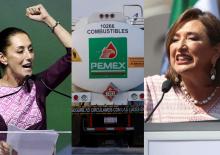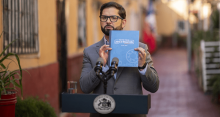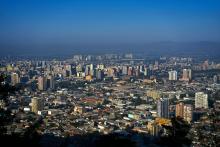
According to the risk rating agency Moody's, private sector confidence accelerates economic growth.
The outlook on the Peruvian debt rating could go from negative to stable towards the second half of this year, said the vice president of Moody's Investors Service, Jaime Reusche.
The economist details the expectations of the rating agency about Peru in an interview given to the Económika Supplement of the Diario El Peruano.
How do you see Peru's growth projections for this year and 2025?
At the moment we have not changed our projection. We expect growth of 2.7% for this year and 2.8% for 2025, in line with the potential we see in the Peruvian economy.
However, it continues to be relatively muted growth for this year, since 2023 was one of contraction. We would expect to see a slightly stronger rebound effect this year; but, in part, we still see some reluctance from the private sector and foreign investors. However, today raw materials are showing very good prices.
It is important to note that a slight recovery was observed in business confidence; However, it is still not strong enough; That is to say, all that confidence that is required from the private sector to accelerate growth this year is not yet in place.
How do you see the performance of the fiscal deficit?
We observe that this year the fiscal deficit will be reduced compared to what it closed in 2023. This index has expanded strongly in the first three months of this year, due to an acceleration of public investment and also because Government income does not They have fully recovered.
So, we see a somewhat challenging situation to reach the 2% deficit goal established for this year.
We believe that it is very likely that the deficit will close to around 2.4% and, therefore, we welcome this initiative by the Minister of Economy and Finance to begin the debate on whether the fiscal goal and the medium-term trajectory.
Without a doubt, this is a deficit with a fairly manageable level for the country; however, it is not a level at which it should be maintained. In relative terms, we do see a much more prudent management of the fiscal deficit in Peru.
How do you see the interest of foreign investment in Peru given the recent awards of public-private partnerships (PPP)?
It is a good start to restart the push that was had before in regards to foreign investment, especially in sectors other than construction and that are also important in the economic performance of the country in aspects such as the generation of employment.
However, we still have to return to the levels at which foreign investment would be giving us much more marked dynamism in the economy, especially in the mining sector, which is a bit unfortunate, since there are very good prices for raw materials. premiums at this time, longer-term investments should be attracted.
In other sectors, such as agriculture, greater investments are not being made because there is still a certain level of reluctance on the part of foreign investors due to the volatility and political noise that affect the country and that must be controlled and mitigated to continue in the sector. way to regain the confidence of foreign investors.
Likewise, the signals that have been shown by the Government related to the unblocking of projects in different sectors are important to consolidate a greater recovery of confidence in the private sector.
What are the expectations for Peru's rating by Moody's?
We have this negative outlook on the Baa1 rating. It should be noted that, at the beginning of last year, the Moody's agency confirmed Peru's credit rating, which is Baa1 (investment grade), due to the solidity of its fiscal accounts, but changed the outlook to negative due to social protests.
On that occasion, Moody's highlighted that the main bastion of Peru's credit profile is its fiscal strength, due to the prudent management that has been maintained in recent decades.
At that time, the negative outlook basically responded to the social protests that occurred, especially at the beginning of last year.
We knew that 2023 was going to be a complicated year in macroeconomic terms and, in effect, the result was a year of contraction. However, despite the difficulties of the economic environment, Peru stood out for its fiscal resilience. We hope to resolve that negative outlook in the second half of the year, most likely returning it to stable, but the question is at what level?
If it is at the current level of the rating or at one slightly lower, that incorporates all these costs that are generating political noise and political volatility; especially if one looks towards the medium term and the 2026 elections with the volatility that this may generate, as well as the uncertainty, then it will be a decision that will take time to resolve the negative perspective.
We must state that the negative outlook usually lasts 12 to 18 months. Therefore, our intention is to resolve this negative outlook by mid-2024, but not beyond mid-2024, to give time for the economy to recover and for economic and political conditions to normalize.
We want to make sure that, in fact, political noise does not complicate fiscal management or create too many costs or limitations for the country's growth. However, we consider that it will be a difficult internal debate because very subjective and qualitative factors must be weighed, including political risk.
What risks are there for Peruvian economic growth? What needs to be improved or strengthened?
If we had a calmer political environment, that allows our good technocrats to work, I believe that growth could be significantly boosted again and a very favorable environment would be generated for fiscal accounts, investment, job creation and, therefore, way, increase the income of Peruvians.
The political class should try to find more consensus. It is essential to reach a greater consensus to establish the necessary conditions of political tranquility that the country requires, in order to give greater incentives to foreign investors to come and bring real investment. That would easily accelerate the growth of Peru and is what it must be searched effectively.
The Ministry of Economy and Finance (MEF) points out that we are already emerging from the recession. How do you see it?
We are seeing a relatively muted rebound in the first months of the year, which should accelerate, and then move on to an expansion in the second half of 2024. That is our vision and we hope it will be so.
We have to continue monitoring the performance of high-frequency indicators, which remain a bit mixed, such as cement shipments and electricity demand, which indicate potential for a much faster and stronger recovery; but, on the other hand, the indicators linked to private investment are still a little weak, so there is a spark missing.
It is essential that the Peruvian population knows how transcendental is the good management of the economy that the country had and that it has still managed to preserve.
Peru maintains its macroeconomic strengths, but must meet the established objectives to accelerate its recovery.
One of the strengths of the Peruvian economy has been its currency compared to other currencies in the region. How do you analyze the behavior of the sun?
The strength of the sol over the dollar is due, in large part, to the rate differential that the Central Reserve Bank of Peru (BCR) has, higher than that of the United States Federal Reserve (FED), which encourages to attract capital.
We also see that the current account deficit has been sharply reduced; In other words, the trade balance surplus has increased where there are more exports than imports.
This, in part, due to the blow that the economy experienced last year, where demand for imports was significantly reduced.
As a result, we had a more favorable trade balance in 2023 and, so far this year, we also see this positive behavior, which implies an increase in the flow of foreign currency to the country.
Business confidence to invest more in the country shows a slight recovery that can increase with greater cohesion, in order to attract capital that generates more employment.










